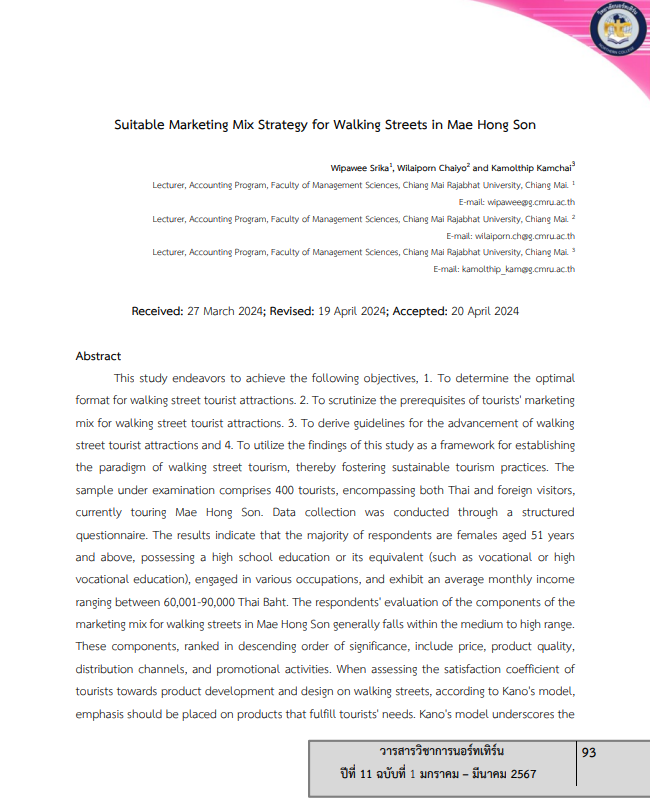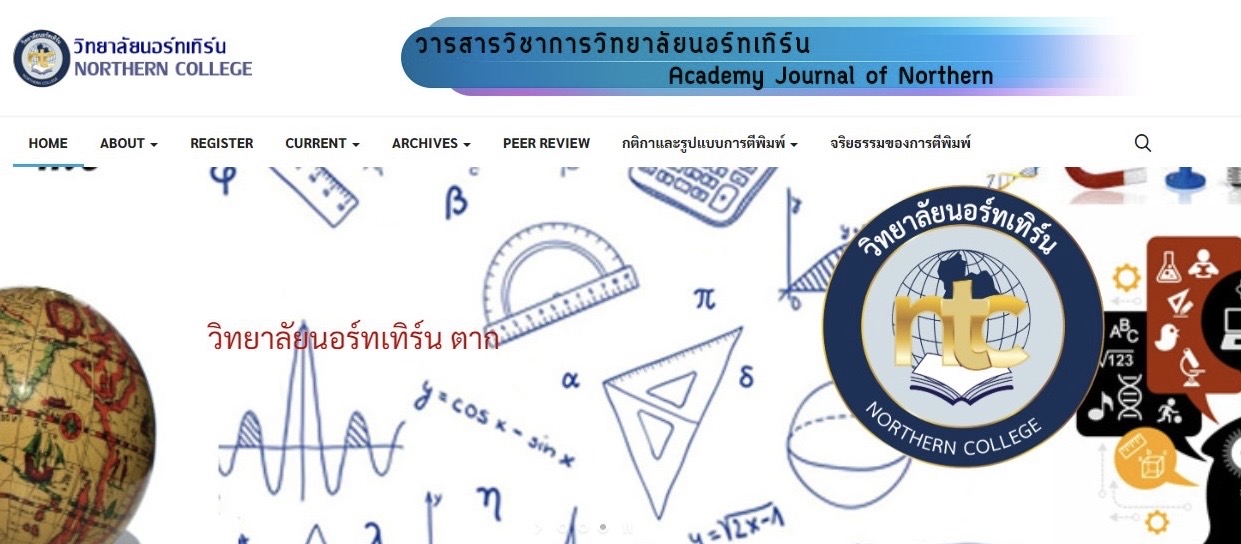Suitable Marketing Mix Strategy for Walking Streets in Mae Hong Son
คำสำคัญ:
Walking Street, Marketing Mix, Mae Hong Sonบทคัดย่อ
This study endeavors to achieve the following objectives, 1. To determine the optimal format for walking street tourist attractions. 2. To scrutinize the prerequisites of tourists' marketing mix for walking street tourist attractions. 3. To derive guidelines for the advancement of walking street tourist attractions and 4. To utilize the findings of this study as a framework for establishing the paradigm of walking street tourism, thereby fostering sustainable tourism practices. The sample under examination comprises 400 tourists, encompassing both Thai and foreign visitors, currently touring Mae Hong Son. Data collection was conducted through a structured questionnaire. The results indicate that the majority of respondents are females aged 51 years and above, possessing a high school education or its equivalent (such as vocational or high vocational education), engaged in various occupations, and exhibit an average monthly income ranging between 60,001-90,000 Thai Baht. The respondents' evaluation of the components of the marketing mix for walking streets in Mae Hong Son generally falls within the medium to high range. These components, ranked in descending order of significance, include price, product quality, distribution channels, and promotional activities. When assessing the satisfaction coefficient of tourists towards product development and design on walking streets, according to Kano's model, emphasis should be placed on products that fulfill tourists' needs. Kano's model underscores the following aspects: prioritizing safety in the tourism area, scheduling programs in advance, ensuring the correlation between price and quality of products and services, and highlighting local culture and tradition during local festivals. Additionally, products sold on walking streets should predominantly showcase local craftsmanship. The results of hypothesis testing reveal that age, education, occupation, and average income of tourists do not significantly vary concerning the elements of the marketing mix.
เอกสารอ้างอิง
Bramwell, B., & Lane, B. (Eds.). (2013). Tourism Collaboration and Partnerships: Politics, Practice, and Sustainability. Routledge.
Chatchaphon Songsunthornwong. (2004). Environmental awareness for sustainable tourism. http://www.stou.ac.th/Tourism/Acheive/May/Topic2.html.
Kano. (1984). Attractive Quality and must be Quality. Hinshitsu. 14(2): pp. 39-48.
Mae Hong Son Focus. (2023). Mae Hong Son Focus (n.d.). http://www.chiangraifocus.com/TravelMaeHongSon/171/MaeHongSonWalkingStreet. (KadChiangHairemembers-returnslifetothecommunity-returnsthestreettopedestrians)
Mae Hong Son Walking Street. (2022). Mae Hong Son Walking Street. https://chiangraiwalkstreet.wordpress.com/about/.
McCarthy, E. J., & Perreault, W. D., Jr. (1996). Basic marketing: A global managerial approach. (12th ed.). Chicago: Irwin.
Mowen, J. C. & Minor, M. (2001). Consumer Behavior. (5th ed.). New Jersey: Prentice-Hall.
Office of the National Economic and Social Development Board, Office of the Prime Minister. (2016). National Economic and Social Development. https://www.dpe.go.th/dwl-files-411891791799.
Phra Maha Sutit Oun. (2007). Study of the potential of local communities in promoting ecotourism Specific case study: KK River route. Thesis-Master of Social Work, Thammasat University.
Pochana Suansri. (2003). Community tourism management manual. Bangkok: Project Travel for Life and Nature.
Prapapen Suwan. (1993). Attitude: Change and health behavior. Bangkok: Thai Wattana Panich.
Rawiwan Olanratmanee. (2004). Walking street in Mae Hong Son urban area: complete research report. Bangkok: Thailand Research Fund.
Rokeach, Milton. (1970). Beliefs, Attitudes and Values. San Francisco: Jossey Basso, Inc.
Rosenberg, R.J. and Hovland, C. I. (1960). Attitude Organization and Change: And Analysis of Consistency Among Attitude Components. Wesport: Greenwood Press.
Samai Apaphirom, Yesanan Chetrat. Thai environmental situation. (1995). Green world, new mental institution. Humanity Bangkok: Brattomrit Printing and Publishing Public Company Limited.
Sauerwein, E., (1997). The Kano Model: How to delight your customers. International Working Seminar on production Economics. Innsbruck/Igls/Igls/Austria, February 19-23 1996, 313-327.
Spencer, H. (1985). A renewed appreciation. London: Sage.
Thailand Institute of Scientific and Technological Research. (1999). Actions to set policy. Travel to preserve the ecosystem. Bangkok: Author.
Thanyakarn Wattananon. (2004). Evaluation of the Walking Street Project. Mae Hong Son Province, Independent research, graduate school Mae Hong Son University.
Tourism Authority of Thailand. (2022). Tourism Authority of Thailand. (n.d.). http://www.thai.tourismthailand.org/home.
Umaporn Panya. (2008). Attitudes of foreign tourists towards souvenir products on the walking street. Ratchadamnoen Road, Mueang District, Mae Hong Son Province. independent research, graduate school Chiang Mai University.
Usana Chaengruangthong. (2010). Factors for the success of the Walking Street in the Ratchadamnoen area. Mae Hong Son Province. independent research, graduate school Mae Hong Son University.
Watchareewan Sasiphon. (2006). Organizing activities for tourism: a case study of walking street activities in Mae Hong Son Province. Thesis, Graduate School Mae Hong Son University.
Yamane Taro. (1973). Statistics: An Introductory Analysis. 3ed. New York: Harper and Row.

ดาวน์โหลด
เผยแพร่แล้ว
รูปแบบการอ้างอิง
ฉบับ
ประเภทบทความ
สัญญาอนุญาต

อนุญาตภายใต้เงื่อนไข Creative Commons Attribution-NonCommercial-NoDerivatives 4.0 International License.






